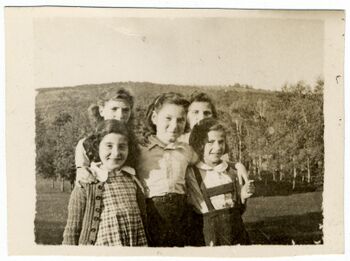Betty Schütz Bloom (F / Germany, 1930), Holocaust survivor

Betty Schütz Bloom (F / Germany, 1930), Holocaust survivor
Ruth Schütz Uzrad (F / Germany, 1925-2015), Holocaust survivor
- KEYWORDS : <Children of La Hille> -- <Germany> -- <Refugees, Belgium> <Home General Bernheim> -- <Refugees, France> <Seyre> <Chateau de La Hille> -- <Refugees, Switzerland>
Biography
Betty Schütz (Bloom) was born in Berlin in 1930, to a religious Jewish family. After the arrest of her father by the Gestapo, Ruth's mother sent 13 year-old Ruth and her two younger sisters out on their escape route across Europe by train to the safety of Belgium. Later, when the Nazis conquer Belgium, Ruth and Betty escaped to France, leaving the youngest sister behind to be taken in by a Belgian foster family. From 1940 to 1943, Betty and her sister lived at the Chateau de La Hille at Montégut-Plantaurel, France. In 1943 Ruth joined the Jewish underground movement in France and took on a false identity and a new name, Renee. Betty was smuggled to safety in Switzerland.
Ham&High(25 February 2012)
An 82-year-old who has lived in Hampstead for more than 50 years has revealed her remarkable escape from Nazi Germany and the friendships she built along the way in a new book about child Holocaust survivors.
Betty Bloom’s story is one of many included in We Remember: Child Survivors of the Holocaust Speak, which was launched at the Wiener Library in Russell Square on February 12.
Mrs Bloom, who was born Betty Schutz in Berlin in 1930, said: “Our generation is not going to be here for long so its important that our history is recorded. For years people didn’t talk want to talk about it and people didn’t want to ask.
“The world should know. Whole families have been lost.”
Mrs Bloom last saw her father on October 28, 1938 after he was deported from their family home in Berlin to Poland and was later killed in the Belsen concentration camp.
After his deportation, Betty, her mother and two sisters spent the Second World War years dispersed across Europe and Mrs Bloom fled from to Belgium to France and Switzerland.
She contracted jaundice and tuberculosis and lived in fear that her elder sister would die fighting for the French resistance.
“Every story in the book is different,” said Mrs Bloom, whose remaining family reached safety in London and Palestine in 1945.
“Some are so sad, like the story of one who after the war discovered a distant cousin and saw a photo of the mother she did not remember, another became a gardener because he was rescued by someone who loved flowers.”
Mrs Bloom’s own tale is bittersweet. She recalls the “kinship” of the Chateau de la Hille Jewish colony in Montegut-Plantaurel, France, where she and her older sister were harboured from 1940 to 1943, and where a museum has since been created.
The many languages she learned during her flight across Europe secured her a career as a multilingual secretary for top companies in London, the city where she met and married Alan Bloom, an engineer.
“I hope the book will be used by schools and museums to inspire and inform future generations,” she said.
“It’s also a useful learning experience or healing experience for the person telling the story.”
Mrs Bloom, who now lives in Fellows Road, has since returned to Germany and Poland to search for records of her father’s death and to put her parents’ lives in context.
External links
- Holocaust Children, 1930 (subject)
- Holocaust Children, Germany (subject)
- Holocaust Refugee Children, Belgium (subject)
- Home General Bernheim (subject)
- Holocaust Refugee Children, France (subject)
- Seyre (subject)
- Chateau de La Hille (subject)
- Switzerland from France (subject)
- Holocaust Refugee Children, Switzerland (subject)